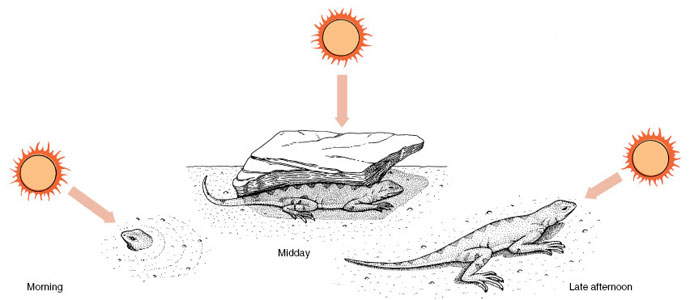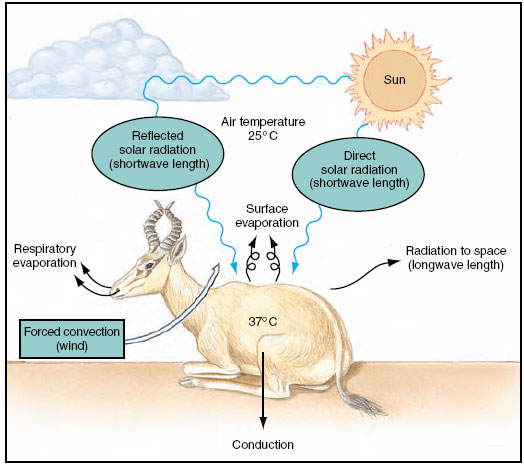How Ectotherms Achieve Temperature Independence
How Ectotherms Achieve
Temperature
Independence
Behavioral Adjustments
Although ectotherms cannot control their body temperature physiologically, many are able to regulate their body temperature behaviorally with considerable precision. Ectotherms often have the option of seeking areas in their environment where the temperature is favorable to their activities. Some ectotherms, such as desert lizards, exploit hour-to-hour changes in solar radiation to keep their body temperatures relatively constant (Figure 32-16). In the early morning they emerge from their burrows and bask in the sun with their bodies flattened to absorb heat. As the day warms, they turn to face the sun to reduce exposure, and raise their bodies from the hot substrate. In the hottest part of the day they may retreat to their burrows. Later they emerge to bask as the sun sinks lower and the air temperature drops.
These behavioral patterns help to maintain a relatively steady body temperature of 36° to 39° C while the air temperature varies between 29° and 44° C. Some lizards can tolerate intense midday heat without shelter. The desert iguana of the southwestern United States prefers a body temperature of 42° C when active and can tolerate a rise to 47° C, a temperature that is lethal to all birds and mammals and most other lizards. The term “coldblooded” clearly does not apply to these animals!
Metabolic Adjustments
Even without the help of the behavioral adjustments just described, most ectotherms can adjust their metabolic rates to the prevailing temperature such that the intensity of metabolism remains mostly unchanged. This is called temperature compensation and involves complex biochemical and cellular adjustments. These adjustments enable a fish or a salamander, for example, to benefit from almost the same level of activity in both warm and cold environments. Thus, whereas endotherms achieve metabolic homeostasis by maintaining their body temperature independent of environmental temperature, ectotherms accomplish much the same by directly maintaining their metabolism independent of body temperature. This metabolic regulation also is a form of homeostasis.
Behavioral Adjustments
Although ectotherms cannot control their body temperature physiologically, many are able to regulate their body temperature behaviorally with considerable precision. Ectotherms often have the option of seeking areas in their environment where the temperature is favorable to their activities. Some ectotherms, such as desert lizards, exploit hour-to-hour changes in solar radiation to keep their body temperatures relatively constant (Figure 32-16). In the early morning they emerge from their burrows and bask in the sun with their bodies flattened to absorb heat. As the day warms, they turn to face the sun to reduce exposure, and raise their bodies from the hot substrate. In the hottest part of the day they may retreat to their burrows. Later they emerge to bask as the sun sinks lower and the air temperature drops.
 |
| Figure 32-16 How a lizard regulates its body temperature behaviorally. In the morning the lizard absorbs the sun’s heat through its head while keeping the rest of its body protected from cool morning air. Later it will emerge to bask. At noon, with its body temperature high, it seeks shade from the hot sun. When the air temperature drops in the late afternoon, it emerges and lies parallel to the sun’s rays. |
These behavioral patterns help to maintain a relatively steady body temperature of 36° to 39° C while the air temperature varies between 29° and 44° C. Some lizards can tolerate intense midday heat without shelter. The desert iguana of the southwestern United States prefers a body temperature of 42° C when active and can tolerate a rise to 47° C, a temperature that is lethal to all birds and mammals and most other lizards. The term “coldblooded” clearly does not apply to these animals!
Metabolic Adjustments
Even without the help of the behavioral adjustments just described, most ectotherms can adjust their metabolic rates to the prevailing temperature such that the intensity of metabolism remains mostly unchanged. This is called temperature compensation and involves complex biochemical and cellular adjustments. These adjustments enable a fish or a salamander, for example, to benefit from almost the same level of activity in both warm and cold environments. Thus, whereas endotherms achieve metabolic homeostasis by maintaining their body temperature independent of environmental temperature, ectotherms accomplish much the same by directly maintaining their metabolism independent of body temperature. This metabolic regulation also is a form of homeostasis.
 |
| Figure 32-17 Exchange of heat between the animal and its environment on a warm day. Blue arrows indicate sources of net heat gain by the animal (all radiation); black arrows are avenues of net heat loss (evaporative cooling, conduction to the ground, longwave radiation into space, and forced convection by the wind). If air and ground temperatures were warmer than the animal, the arrows for forced convection, conduction, and radiation would be reversed. Then the animal could lose heat only by evaporative cooling. |




